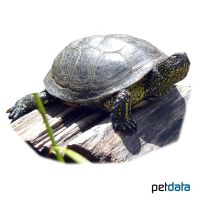European Pond Turtle (Emys orbicularis)
| European Pond Turtle Emys orbicularis | |
|---|---|
| Name | European Pond Turtle |
| Name Lat. | Emys orbicularis |
| Family | Pond Turtles & Box Turtles |
| Family lat. | Emydidae |
| Order | Turtles |
| Order lat. | Testudines |
| Origin | Europe |
| Habitat | Overgrown waterbodies |
| Diet | Fish, insects, plants |
| Humidity | 50-70 % |
| Behavior | Peaceful |
| Keeping | Individual, pair, group |
| Care Level | Moderate |
| Reproduction | Oviparous |
| Housing | Aquaterrarium, Pond |
| Life Span | 15-20 years |
| Protection | EU FFH-Directive Annex IV |
| Metric Units | |
| Size | 11-20 cm |
| Temperature | 20-25 °C |
| Temperature Local | 32-35 °C |
| Housing Size | 120 x 60 x 60 cm |
| US Units | |
| Size | 4.3"-8" |
| Temperature | 68-77 °F |
| Temperature Local | 90-95 °F |
| Housing Size | 45" x 25" x 25" |
Distribution and habitat
The distribution range extends from western Asia via northern Africa to southern and central Europe. Also in Austria there are still some populations (Danube oxbow lakes). They live in heavily weedy, stagnant and slow-flowing waters.
Maintenance
Minimum dimensions for the aquaterrarium, according to the size and number of animals
| floor space for 1-2 animals: 5PL x 2,5PL (L x W) | Water level: 2PB |
The carapace length (PL) and carapace width (PB) is measured on the largest animal. For each additional animal, increase the footprint by 10%, and for the 5th animal and larger, increase the footprint by 20%. An aquaterrarium of e.g. L 120 x W 60 x H 60 cm is recommended, which should be placed in a quiet and vibration-free place.
It needs a spacious, well structured aquaterrarium. The water part, with a soft, muddy substrate, should be structured with roots, aquatic plants and larger stones (visual barriers and hiding places), some of which reach the water surface. For this purpose, they need a terrestrial part (approx. 1/3 of the bottom surface) for drying, which is equipped with a soft, muddy-sandy bottom substrate, with plants and roots as well as with sunning places. To maintain water quality, a powerful filter with low flow is recommended, as well as frequent water changes
| Water Temp | Lighting | Sunny | |
| Summer | 20-25 °C | 12-14 hrs. | 32-35 °C |
| winter (3-5 months) | 4-8 °C | 6-8 hrs |
They need daily UV irradiation and sunny places with radiant heat.
Diet
The diet consists of insect larvae, snails, earthworms, mealworm larvae, shrimp, fish pieces, scraped beef or liver, supplemented with pelleted or freeze-dried ready-to-eat food. Frozen food is also well accepted. In addition, lettuce, dandelion, endive and aquatic plants (e.g. waterweed) should be offered. Young animals should be offered food daily, adults twice a week. Regular addition of minerals and vitamins is important
A varied diet promotes health and prevents deficiency symptoms.
Reproduction and breeding
Males have a concave ventral carapace and a much longer tail than females. The anal opening of the male is closer to the tip of the tail than in the female
Mating occurs in the water in the spring and egg laying (up to 16 eggs) occurs between May and June. A small, sandy shore is necessary for egg laying. The incubation period is 52-107 days (usually 70 days) at a temperature of 24-30 °C.
Life expectancy can be 15-20 years.
Species protection
The animal population must be reported in writing to the competent authority immediately after the start of keeping. Subsequently, all arrivals and departures must be reported. Your pet store will be happy to provide you with further information.
Protection of species: EU FFH Directive Anahng IV. The proof of purchase is the required proof of origin for the animal. Please keep it safe!
Important
They can be kept all year round in the garden pond with a minimum water depth of 1 m.
Hibernation lasts 3-5 months depending on the origin of the animals and takes place in water (skin respiration!) or in moist substrate at 4-8 °C
The terrarium must have good ventilation without drafts and meet the species-specific needs. Measuring devices such as thermometers, hygrometers etc. are necessary. The lighting has to correspond to the species-specific day-night rhythm and has to be placed in such a way that the animals cannot injure themselves. The terrarium should be locked in such a way that neither unauthorized persons can open it nor the animals can escape. Contamination must be removed regularly.
Further literature can be found in your pet store.
References
Text: Christian Sänger; Image: petdata
Source: BMELV (1997): Tierschutzgutachten - Mindestanforderungen an die Haltung von Reptilien; ENGELMANN (2006): Zootierhaltung - Tiere in menschlicher Obhut: Reptilien und Amphibien, Verlag Harri Deutsch
- Gemäß § 21 Abs. 5 Tierschutzgesetz idgF
